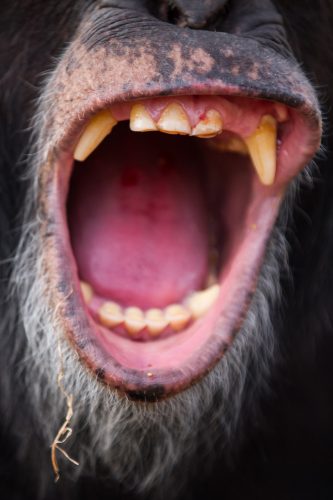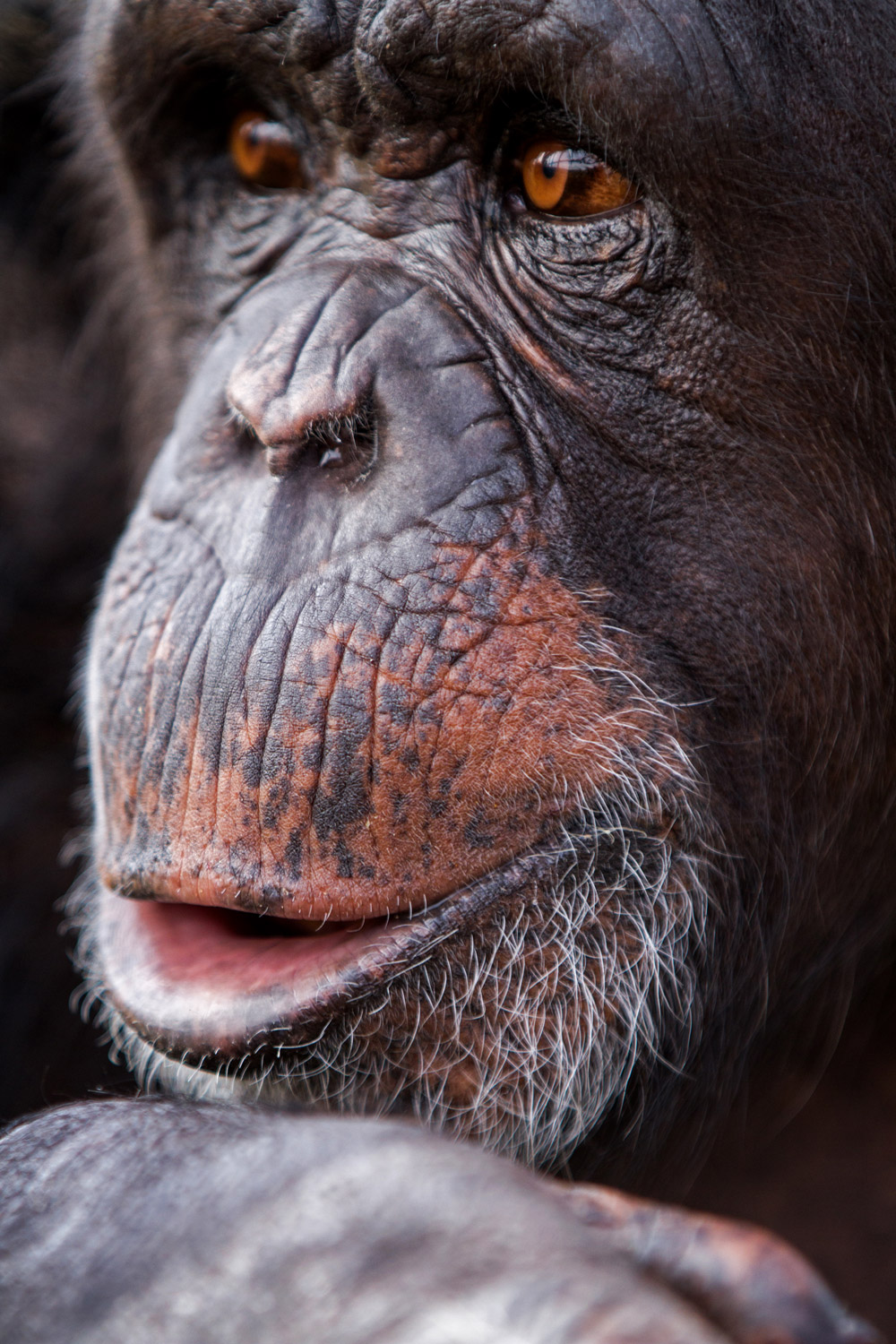
On a stifling summer day in Oregon’s high desert, I drive past several ranches with cattle, horses, goats and a few llamas or alpacas. I arrive at a large gate, where I’m buzzed in, and park at the end of a long rocky driveway.
Massive fences and hot wires mark the boundaries of this animal sanctuary. They tower dozens of feet above me as I walk to meet Marla O’Donnell, the executive director. As we begin our tour, we walk by the window of an indoor habitat and are interrupted by a sudden but distinct raspberry sound.
“Oh, that’s Herbie,” O’Donnell says. “Can you say hi to her? Can you say hi to Corinne?” O’Donnell asks.
Herbie is 31 years old and weighs 150 pounds. He brushes his teeth every morning. In his hands he’s clutching a small pink Hello Kitty hat. The hair on his arms ends at his wrists, and his jointed fingers and fingernails look just like mine.
“It’s very nice. Is that for her? Say, ‘Yes!’ Can you put it on?” O’Donnell asks me.
“Will he know if I put it on?” I asked.
“Oh, yes,” O’Donnell says. “He’ll probably clap.”
Herbie stuffs the pink hat through a window into O’Donnell’s hands. I put on the hat, which has a sequined bow.
“Oh, this is nice, do you like it?” O’Donnell asks Herbie. Eventually, Herbie shows me his teeth and opens his mouth wide. I’d like to think he’s smiling at me, but he could be responding to the command that O’Donnell has given him telling him to open his mouth.
O’Donnell says Herbie is an awkward chimpanzee because he was raised by humans. Socializing with other chimpanzees isn’t Herbie’s cup of tea. Being surrounded by his own personal comforts, which include hats, magazines, the radio, toys and recliners, creates a much more comfortable environment for Herbie.
Herbie lives at Chimps Inc. — a chimpanzee sanctuary just outside Bend — with six other chimpanzees. It was founded 22 years ago, and O’Donnell has worked there for 13 years. The five-acre facility operates on roughly a $300,000 budget, according to its most recent filing as a nonprofit organization.
“Our chimps come from the pet or entertainment industry,” she says. “We’ve got two girls that came from Marine World; the rest came from pet or roadside-zoo type situations. We have seven chimps and a large cat.”
O’Donnell and I walk through the main path of the sanctuary — overhead are aerial tunnels connecting one part of the outdoor habitat to another.
“My girls are up here. Ladies, come here. What are you doing? Where’s C.J.? Ceej,” O’Donnell says, calling for the chimpanzees. A few of the chimps begin making their way over to us as they hear O’Donnell’s voice.
The sanctuary’s youngest chimp, Emma, is 15.
“What are you guys doing? Where is everybody? Are y’all snoozing? You’re being silly,” O’Donnell says.
Next, I’m introduced to C.J. — Calamity Jane. O’Donnell says that, until 2015, chimpanzees were split-listed — they were endangered everywhere except the U.S. But in June of 2015, the U.S. Fish and Wildlife extended the endangered classification to include captive chimpanzees.
O’Donnell says the going rate for a baby chimpanzee ranged from $35,000 to $60,000.
According to USFW spokeswoman Christina Meister, the Endangered Species Act was extended to include captive chimpanzee populations in 2015 — meaning no one is allowed to import or export a chimp to or from the U.S. Selling, possessing or harming chimpanzees by trapping or even attempting to harm or kill them are all violations of the ESA.
However, “Permits are not required for holding legally acquired chimpanzees in captivity or for normal husbandry practices for maintaining the health of the animal,” according to USFW.
Enlarge

Photograph courtesy Will Saunders
O’Donnell is dividing her attention between a chimo and me. “So we fought and fought to try and get them classified as endangered to provide them some more protection, and it does — leave the door alone! — it’s just not exactly where we want to be,” O’Donnell says. “How come you’re trying to shut the door? Who did you want to lock out? Oh, Jackson? Yeah. I don’t blame ya. Here he comes.”
Jackson is a 16-year-old adolescent male who is a bit of a brat, O’Donnell says. He was castrated as a baby, so he won’t grow to be as big as Herbie.
The staff at Chimps Inc. does behavioral training with the chimps as a way of allowing the primates to participate in their own health-care management. For example, O’Donnell can give four or five commands and the chimpanzees will follow them.
C.J. points at O’Donnell’s watch and hair tie. “Do you want to see the hair tie? Give me your finger. Look — we paint their fingernails sometimes — but I want that back,” she says. C.J. puts the hair tie around her wrist.
With her back to me, C.J. stares at O’Donnell, listening to her every word while she runs her fingers around O’Donnell’s hair tie. The two are very close, O’Donnell says. “She has such a loyalty to me that she would probably s-p-i-t on you, so I’m going to try and keep her from doing so.”
O’Donnell rescued C.J. after she escaped a backyard enclosure, and Las Vegas advised the former owners that the chimp was no longer welcome in the city.
“She doesn’t like many people. I spent a week in a van with her, rescuing her,” O’Donnell says. “I flew to Vegas and rented a cargo van and borrowed a tiger transport cage from one of the magicians at a casino and drove back with her.”
C.J. hands back the hair tie and begins rocking — a behavior observed in chimps if they are taken away from their mothers too soon, O’Donnell explains.
In captivity, Chimps live to 55 or 60, according to O’Donnell. Though the sanctuary is not, with seven chimps, at capacity, it is also not in a financial position to take on more rescues. Because its chimps aren’t used for research, the nonprofit doesn’t qualify for federal funding, O’Donnell says. Chimps Inc. solely relies on fundraisers and donations.
The chimps eat 10 to 12 pounds of produce each day. It costs approximately $1,200 per chimp per month to provide each chimp with food, medicine, staff and health care.
Our next stop is in an indoor enclosure. Tunnels lead to cages where the chimps are fed. At all times, I am separated from the chimps, and O’Donnell says no one is allowed to go into the enclosures.
“They are very tricky, and they’re not mean, but they’re wild animals. And so we have to realize that they are eight times stronger than we are,” O’Donnell adds.
The chimps are never kept in cages and are always free to roam; the enclosure is the space where the chimps are fed, and they can leave through the tunnel that leads back outside.
Inside the indoor habitat I meet Patti. She and I were both born in 1984. “Patty used to do tricks at Marine World,” O’Donnell says. “Drink please? Ok, I will get you a drink. More?”
Today the staff is making ice tea for the chimps.
Herbie joins us in the indoor area in his own feeding space. Herbie continues to point at my sunglasses and at my phone, then looking at O’Donnell — it’s almost like he’s asking her who I am. Herbie recognizes that I’m a new face in the sanctuary.
Because O’Donnell has spent so much time with the chimps, she says, “they recognize my car. They’ll scream when they see my car coming.”
Before heading outside to get his treat, Herbie looks at the water bottle on top of his cage in the feeding area. “Can I have your trash?” O’Donnell asks. Herbie hands her scraps and peanut shells through the cage. He looks up at the empty water bottle on top of the enclosure, then he pokes at it until the bottle falls off. O’Donnell catches it.
“They love music, they love to watch SpongeBob on TV. Topo likes Seinfeld. So good of you to clean your own bedroom,” O’Donnell says.
At 51, Topo is the sanctuary’s alpha male. He and Herbie are kept in separate groups to avoid a battle for status. O’Donnell says Topo would probably die if the two ever faced off because he’s too old to fight.
The similarities between Herbie and me are staggering. I watch him choose and open a snack package — an enrichment activity and snack that the staff makes every day — and he separates the shredded newspaper from the dried apples, peanuts and pretzels.
Enlarge

Photograph courtesy Will Saunders
Jane Goodall was the first person to discover that chimpanzees make and use tools; the primatologist has spent 50 years researching and working to protect the closest living relatives to humans, according the Jane Goodall Institute’s website.
As she immersed herself in the wilds of Tanzania, Goodall witnessed chimpanzees using sticks to remove termites from mounds. Though this discovery was made in 1960, watching a chimp trying to interact with me was surreal.
If chimps are born in captivity, or are taken away from their mothers as babies, they cannot return the wild. As with other captive wild animals, they don’t possess the behaviors that allow them to hunt or to protect themselves. Yet human-caused destruction of their natural habitat, as well as poachers, continues to decimate the chimpanzee population throughout a habitat that spans across 22 African countries, according to U.S. Fish and Wildlife Service.
Chimps Inc. formed and is a member of the American Primate Sanctuary Alliance, created “to develop a standard of care for captive chimps and to try to get the chimps out of research and out of these private sectors,” O’Donnell says.
“So we’re on the placement team,” she adds. “If we know of a chimp that is in need of a home, that somebody is going to release, we’ll jump into action to try to find way to get the transport, the medical done and all that, and place them with an accredited sanctuary.”
As Herbie finishes his snack, he listens as O’Donnell asks him to back up so she can take his photo. He seems to be right at home in the only chimp sanctuary in Oregon, where he’ll spend the rest of his life with familiar caregivers and remain protected from the wild.